
The Victory ship was a class of cargo ship produced in large numbers by American shipyards during World War II to replace losses caused by German submarines. They were a more modern design compared to the earlier Liberty ship, were slightly larger and had more powerful steam turbine engines, giving higher speed to allow participation in high-speed convoys and make them more difficult targets for German U-boats. A total of 531 Victory ships were built in between 1944 and 1946.

Liberty ships were a class of cargo ship built in the United States during World War II under the Emergency Shipbuilding Program. Although British in concept, the design was adopted by the United States for its simple, low-cost construction. Mass-produced on an unprecedented scale, the Liberty ship came to symbolize U.S. wartime industrial output.
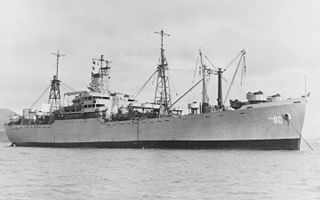
Type C2 ships were designed by the United States Maritime Commission (MARCOM) in 1937–38. They were all-purpose cargo ships with five holds, and U.S. shipyards built 328 of them from 1939 to 1945. Compared to ships built before 1939, the C2s were remarkable for their speed and fuel economy. Their design speed was 15.5 knots (28.7 km/h), but some could make 19 knots (35 km/h) on occasion. The first C2s were 459 feet (140 m) long, 63 feet (19 m) broad, and 40 feet (12 m) deep, with a 25-foot (8 m) draft. Later ships varied somewhat in size. Some, intended for specific trade routes, were built with significant modifications in length and capacity.
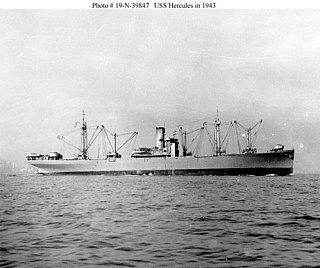
Type C3-class ships were the third type of cargo ship designed by the United States Maritime Commission (MARCOM) in the late 1930s. As it had done with the Type C1 ships and Type C2 ships, MARCOM circulated preliminary plans for comment. The design presented was not specific to any service or trade route, but was a general purpose ship that could be modified for specific uses. A total of 162 C3 ships were built from 1939 to 1946.

The Type C4-class ship were the largest cargo ships built by the United States Maritime Commission (MARCOM) during World War II. The design was originally developed for the American-Hawaiian Lines in 1941, but in late 1941 the plans were taken over by the MARCOM.
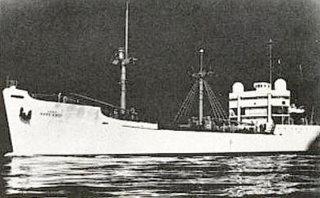
USNS Rose Knot (T-AGM-14) was a World War II era United States Maritime Commission small cargo ship built in 1945 and delivered to the War Shipping Administration for operation through agent shipping companies and for periods by the Military Sea Transportation Service (MSTS). In 1957 the ship was transferred to the Air Force and converted into a missile range instrumentation ship which operated as USAFS Rose Knot on the U.S. Air Force's Eastern Test Range during the late 1950s and early 1960s. Rose Knot operated under an Air Force contract with Pan American Airways Guided Missile Range Division headquartered in Cocoa Beach, Florida. In July 1964, all Air Force tracking ships were transferred to MSTS for operation with the Air Force in operational control while the ships were at sea as tracking ships. Rose Knot had special facilities for supporting the human spaceflight program and supported the early crewed flights. The ship was owned by the U.S. government until sold for non-transportation use in 1977.
USNS Sgt. George Peterson (T-AK-248) was a US Maritime Administration (MARCOM) C1-M-AV1 type coastal cargo ship, originally planned as an Alamosa-class cargo ship. The contract for building was canceled by the Navy in August 1945. The ship, however, was completed as SS Coastal Guide. She was later acquired by the US Army, in 1948, and renamed USAT Sgt. George Peterson. She was reacquired by the Navy, in 1950, and placed in service by the Military Sea Transportation Service (MSTS) as USNS Sgt. George Peterson (T-AK-248). She remained with the Navy until struck in 1966. She was sold in 1971.
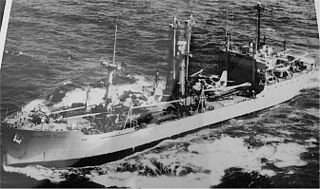
USNS Colonel William J. O’Brien (T-AK-246) was a US Maritime Administration (MARCOM) C1-M-AV1 type coastal cargo ship, originally planned as an Alamosa-class cargo ship. Constructed as Maiden's Eye for the MARCOM, completed in August 1945 and placed in operation by the War Shipping Administration (WSA). After the war Maiden's Eye was transferred to the US Army and renamed USAT Colonel William J. O’Brien who kept her in service until transferred to the US Navy in 1950 for operation as USNS Colonel William J. O’Brien (T-AK-246) by the Military Sea Transportation Service (MSTS) until 1973.
USNS Private John F. Thorson (T-AK-247) was a US Maritime Administration (MARCOM) C1-M-AV1 type coastal cargo ship, originally planned as an Alamosa-class cargo ship. Constructed as Becket Bend for MARCOM, completed in August 1945 and placed in operation by the War Shipping Administration. However, the war ended, and she was transferred to the US Army as USAT Private John F. Thorson who kept her in service until transferred to the US Navy in 1950. She was struck in 1960, ending her military career.

USNS Private Frank J. Petrarca (T-AK-250) was a US Maritime Administration (MARCOM) C1-M-AV1 type coastal cargo ship, originally planned as an Alamosa-class cargo ship. Constructed as Long Splice for MARCOM, completed in September 1945 and placed in operation by the War Shipping Administration (WSA) during the closing period of World War II. However, the war ended, and she was transferred to the US Army as USAT Private Frank J. Petrarca who kept her in service until transferred to the US Navy in 1950.
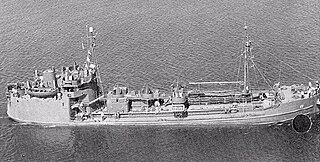
The T1 tanker or T1 are a class of sea worthy small tanker ships used to transport fuel oil before and during World War II, Korean War and Vietnam War. The T1 tanker classification is still in use today. T1 tankers are about 200 to 250 feet in length and are able to sustain a top speed of about 12 knots. The hull designation AO is used by the US Navy to denote the ship is a T1 oil tanker and AOG that the T1 is a gasoline tanker. The small size allows the T1 to enter just about any sea port or to anchor around a small island, this was very useful during the Pacific War. The T1 tanker can carry about 48,000 to 280,000 bbls. Some T1 tankers were used to transport goods other than oil, a few were used for black oil-crude oil, diesel, chemicals and rarely bulk cargo like grain. T1 tankers are also called liquid cargo carriers. The T1 tanker has about a 6,000 to 35,000 deadweight tonnage (DWT) of cargo. The small size also gives the ships short turn around time for repair, cleaning, loading and unloading. A T1 tanker carrying dirty cargo, like crude oil needs a few weeks of labor to clean before carrying clean cargo. Most T1 ships during World War II were named after major oil fields.
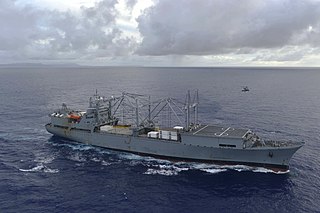
The Type C5 ship is a United States Maritime Administration (MARAD) designation for World War II breakbulk cargo and later a container ship for containerization shipments. The first type C5-class ship was a class of ships constructed and produced in the United States during World War II. The World War II C5-class ship was dry bulk cargo ship built by Bethlehem Steel in Sparrows Point, Maryland. Bethlehem Steel built eight ships in this bulk cargo class and four orders were canceled. The C5-class ship has a 24,250 DWT and was 560 feet (170 m) long. The C5 was mainly used as iron ore carriers. The C5 was needed to replace other ships that sank during World War II. First in her class was SS Venore, USMC #1982, delivered on 20 July 1945. The Type C5-class ship designed to fill the need to move iron ore from Santa Cruz, Chile, to Sparrows Point, Maryland, through the Panama Canal, a round-trip of 8,700 nautical miles . Post World War II, four ships were given C5 class type C5-S-78a, these were roll-on/roll-off container ship built by Ingalls Shipbuilding, Inc. of Pascagoula, Mississippi and operated by the Moore-McCormack Lines. The C5-S-78a had a deadweight tonnage of 16,000 tons.

The Type R ship is a United States Maritime Administration (MARAD) designation for World War II refrigerated cargo ship, also called a reefer ship. The R type ship was used in World War II, Korean War, Vietnam War and the Cold War. Type R ships were used to transport perishable commodities which require temperature-controlled transportation, such as fruit, meat, fish, vegetables, dairy products and other foods. The US Maritime Commission ordered 41 new refrigerated ships for the US Navy. Because of the difficulty of building refrigerated ships only two were delivered in 1944, and just 26 were delivered in 1945 and the remainder in 1946–48. The 41 R type ships were built in four groups. Two of design types were modified type C1 ships and two were modified type C2 ships. The United Fruit Company operated many of the R type ships in World War II. The type R2-S-BV1 became the US Navy Alstede-class stores ship and the type R1-M-AV3 became the US Navy Adria-class stores ship.
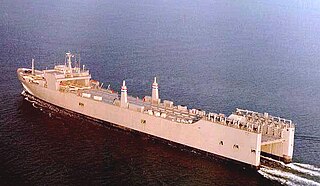
Type C8-class ships are a type of Heavy Lift Barge Carrier. Type C8 ships were the 8th type of ship designed by the United States Maritime Commission (MARCOM) in the late 1960s. As done with the Type C1 ships and Type C2 ships, MARCOM circulated preliminary plans for comment. The design presented was not specific to any service or trade route. Type C8 ships measuring 876 feet (267 m) from stem to stern, and designed to make 16.2 knots.

The McDougall Duluth Shipbuilding Company was a large-scale wartime ship manufacturing shipyard, located at the city of Riverside, near Duluth. McDougall Duluth Shipbuilding was at 110 Spring Street, Duluth, Minnesota, now the site of the West Duluth's Spirit Lake Marina. The shipyard was located on St. Louis River Estuary at western part of Lake Superior. McDougall Duluth Shipbuilding Company was founded by Alexander McDougall (1845-1923) in 1917 to build ships for World War I. McDougall Duluth Shipbuilding Company and the Superior Shipbuilding Company were called the Twin Ports shipbuilding industry of Minnesota and Wisconsin. Once built the ships can travel to the Atlantic Ocean through the Great Lakes and the Saint Lawrence Seaway.

Walter Butler Shipbuilders Inc. was a large-scale World War II ship manufacturing shipyard, located at Superior, Wisconsin, United States. Walter Butler purchased the shipyard from Lake Superior Shipbuilding in 1942. Walter Butler Shipbuilders Inc. was at E 1st St, Superior, Wisconsin. The shipyard was located on the western part of Lake Superior. Walter Butler Shipbuilders Inc. was found by Walter Butler in 1942 to build ships for World War II. Walter Butler Shipbuilders Inc., the McDougall Duluth Shipbuilding Company and the Superior Shipbuilding Company were called the Twin Ports shipbuilding industry of Minnesota and Wisconsin. Once built the ships can travel to the Atlantic Ocean through the Great Lakes and the Saint Lawrence Seaway.

A. H. Bull Steamship Company was a shipping company and passenger liner service founded in New York City in 1902 by Archibald H. Bull (1848-1920). Service started with shipping between New York and Florida. His fleet of ships then added service to other Eastcoast ports. The company is also often called the Bull Lines and the Bull Steamship Line or A. H. Bull & Company. While founded in New York, Bull soon move its headquarter to Peir 5 in Baltimore, Maryland. Bull Lines main Eastcoast ports were: Baltimore, Charleston, Philadelphia, Tampa and Norfolk, Virginia. Oversea ports: Porto Rico, Antwerp, Bordeaux, Hamburg, Bremen, Copenhagen, and West Africa. Bull Steamship Line supported the US war effort for both World War I and World War II, including the loss of ships.

Bethlehem Beaumont Shipyard was a shipyard in Beaumont, Texas that opened in 1948. The yard is located on an island in the Neches River and upstream of the Sabine Pass that grants access to the Gulf of Mexico. The deep-water port shipyard was founded in 1917 as the Beaumont Shipbuilding & Dry Dock Company. Beaumont Shipbuilding & Dry Dock Company started as a World War I Emergency Shipbuilding Program yard.

Froemming Brothers of Milwaukee, Wisconsin was a shipyard that built ships for World War II under the emergency shipbuilding program, War Shipping Administration and United States Navy. Froemming Brothers shipyard was opened in 1942 by Ben Froemming (1902-1945). Froemming Brothers closed after the war in 1945, after building 26 ships. The shipyard was located on the north side of the Kinnickinnic River. The shipyard had 2,400 workers in three shifts. In 1945 it was sold to Wagner Iron Works and later sold to the Milwaukee Marine Yacht. The site today is Horny Goat Marina, Blue Max Charters and Clete Long Enterprises. The shipyard was in Bay View, Milwaukee neighborhood at 43.008597°N 87.911697°W.
Sword Line Inc. was a steamship company founded by Charilaos "Charles" G. Poulacos and Abbott Abercrombie in New York City in 1933. Sword Line Inc. had shipping routes from Atlantic ports to and Gulf of Mexico ports. Charilaos "Charles" G. Poulacos and Abbott Abercrombie purchased the ship Eastern Sword in 1932. The Eastern Sword was a 3,785-ton cargo ship built in 1920 at the Uraga Dry Dock Co. Ltd, at Uraga, Japan. The ship sank after being hit by a torpedo from German submarine U-162 on May 4, 1942 twelve miles (19 km) off the coast of Georgetown, Guyana. The Eastern Sword had a crew of 38 and only 13 survived the attack. Sword Line Inc. was active in supporting the World War II effort.





















